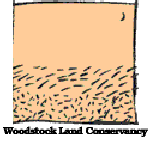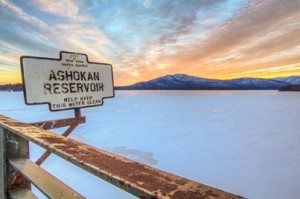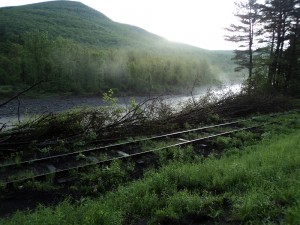Can’t we all just get along? Let’s have both a tourist railroad and a fully accessible 38 mile trail. At first glance this sounds fantastic. Especially when compared to those trail nuts that want to rip up our historic rails and build ANOTHER trail. As always, however, the devil is in the details.
I interned for the non-profit organization, Woodstock Land Conservancy (WLC),
which is based in Woodstock, New York. In 2012, WLC formed the Friends of the Catskill Mountain Rail Trail (CMRT) to promote an initiative by the county executive, and take advantage of a window of opportunity along the Ulster and Delaware (U&D) rail corridor in Ulster County.
This section of the U&D corridor is owned by the county and is leased to the Catskill Mountain Rail Road Company Incorporated (CMRR). The “window of opportunity” is the fact that this lease is due to expire in 2016. The Friends of the CMRT formed in order to advocate for building a rail trail in the corridor as opposed to renewing the scenic tourist railroad’s lease.
|
Catskill Mountain Rail Road |
Catskill Mountain Rail Trail |
|
|
Friends of the CMRT advocates directly to the Ulster County Legislature, as well as educating the public about the benefits that the trail will provide. My task as an intern for the Friends of the CMRT was to create a Membership and Outreach Coordinator position and to serve as the initial coordinator. In this position, I had a wide range of tasks, including: improving outreach and communications material, organizing speakers at the Ulster County legislature meetings, facilitating community meetings along the U&D corridor, writing grant proposals and building relationships to other organizations.
Every day of the internship I used skills from my first year at Bard Center for Environmental Policy (CEP), especially from my policy classes. Key to this project was framing of the issues. When framing an issue for the general public, the message needs to be clear and simple. The public has many other things to think about.
The Friends of the CMRT could have benefited from some better framing early on, specifically in relation to rail and trail together. The CMRR was extremely good at framing this issue in such a way as to garner public support. They made a point, in all of their outreach and literature, of emphasizing their desire for a trail that runs parallel to the existing train tracks. They cite other locations where this has been successful, omitting the fact that these examples are not remotely comparable, and portray the Friends of the CMRT as being uncompromising. The truth is that running a trail next to the existing rail line is NOT feasible.
Reasons that rail next to trail is not feasible in this corridor:
1. It is too narrow.  Unlike the many successful rail-with-trail examples that CMRR cites, the U&D corridor is only a single track wide, and in order to put in a trail next to it, you would need to fill in wetlands, take private land via eminent domain, and rebuild existing or failed bridges to railroad standards (at great expense).
Unlike the many successful rail-with-trail examples that CMRR cites, the U&D corridor is only a single track wide, and in order to put in a trail next to it, you would need to fill in wetlands, take private land via eminent domain, and rebuild existing or failed bridges to railroad standards (at great expense).
2. It poses significant safety and liability issues as it causes the trail to cross the rail in places and forces the trail onto streets in others.
3. It undermines the quality of the trail and decreases the recreational uses and attractiveness of the trail, especially for people with disabilities (the rail bed never goes over a 2% grade, the proposed trail next to it would have to be steeper in order to negotiate many physical features adjacent to the railbed).
4. It jeopardizes needed funding and agreements with outside stakeholders (e.g., NYC DEP).
This understanding, however, requires an inductive leap. People need to be informed on the issues. Since most people do not take the time, the framing of CMRR as compromising and the Friends of the CMRT as extremists is an effective ploy.
In my position as Membership and Outreach Coordinator, I helped people to make this leap and encouraged them to help others understand the issue as well. Though it would have been better to have been ahead of CMRR on the framing of this issue, when the facts are on your side, people will listen. Evidence of that can be found in the $3.5 million recently provided by the New York DEP, to facilitate and fund the CMRT and create multiple trailhead access points along the northern side of the Ashokan Reservoir (see an article here).

For additional information on the rail next to trail debate please see: the Friends of the CMRT’s website, resource page.
If you have any questions or comments for me, I look forward to hearing from you (just e-mail me here).

